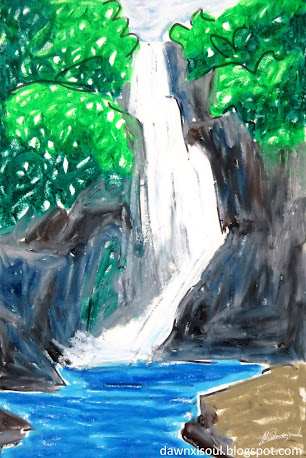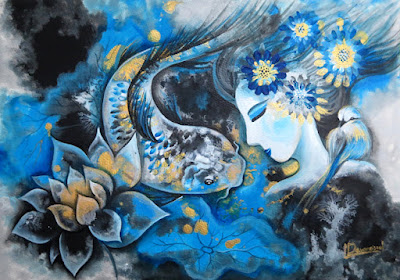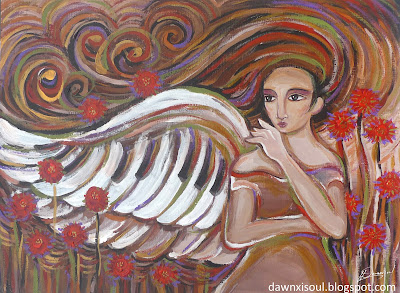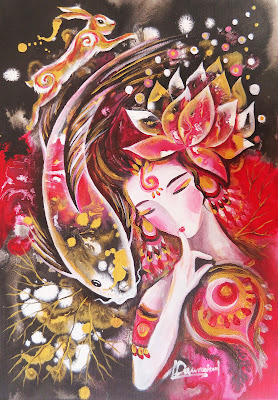June 7 (Lunar calendar: April 20), 2023 Wednesday | Dawnxisoul393art
《Charming Stanley Coast》, painted by dawnxisoul393
Stanley, Hong Kong - A Town where East Meets West:
Today, the whole family went to The Red Pillar(Stanley)Peninsula to sketch and paint. "The Red Pillar" (Stanley)is a beautiful town located in the southernmost part of Hong Kong Island, east of "Repulse Bay" and west of "Shek O", 20 kilometers from Central. It is said that in the past, there was a huge kapok tree in this small fishing village, and when the kapok was in bloom, it looked like a red wooden pillar from a distance, so people in the vicinity named the village after "The Red Pillar". Stanley has many beautiful beaches, such as Stanley East Bay, which is one of the "Eight Views of Hong Kong". What does it have to do with "Stanley"? The name Stanley came from former British Prime Minister Lord Stanley. The double-decker bus to Stanley left the bustling city and entered the lush countryside, winding down the hills along the panoramic road. We were in the middle of the mountains and the water, enjoying the overlapping transformation of the urban landscape and the natural scenery along the way.
Illustrated by dawnxisoul393
After leaving the urban area, the bus has been running on the winding mountain highway, which is both exciting and pleasing to the eye. Passing through the deepwater bay and repulse bay, we enjoyed beautiful sea view villas and chic sea views. It really responds to the sentence: "the most beautiful scenery is on the road. Soon the bus we took arrived in Stanley. Our sketching and painting route today: Stanley square - Po Kung square - Murray House - Stanley Street (yellow street) -Stanley bazaar - Stanley Beach. "The Red Pillar" (Stanley) has been one of the main Aboriginal settlements of Hong Kong Island since ancient times, and the name "The Red Pillar" (Stanley) was already marked in the local gazetteers of the Ming Dynasty. The first census conducted by the British in May 1841 showed that more than 2000 of the 3650 Aboriginal residents on Hong Kong Island lived in Stanley. When Hong Kong became a British jurisdiction in 1842 and the Victoria area was not yet completed, Stanley was the administrative center of Hong Kong Island.
Illustrated by dawnxisoul393
Stanley used to be a small, sparsely populated village and was even infested with tigers (in the Tin Hau Temple in Stanley, the skins of tigers hunted in those days are still preserved). It is also an excellent place for cruise and surfing, and the most heavily guarded prison in Hong Kong is also located here. Later, although the administrative center of Hong Kong was changed to the Sheung Wan District of Hong Kong Island, however, Stanley is still one of the predominantly British residential areas. The biggest feature of Stanley is the style full of antiquity and harmony between Chinese and Western culture. The architecture of Stanley has a strong Western color, and when people are in it, they have the illusion of being in a foreign country. Stanley Street is a pedestrian street near the East Coast of Stanley Bay. On one side of the road is the sea, with reefs, sea breeze, small islands floating in the distance, and fishing boats with sirens blaring. On the other side of the road is a row of tenement buildings but six stories high, crowded with bars and western restaurants.
Across the street was the Stanley Market, which was like crossing over to Europe in a few steps. Stanley Market was back-to-back with Stanley Main Street and was actually a cheap small goods market, where we saw all kinds of stalls, ready-to-wear stalls selling leather goods and silk fabrics, small craft and souvenir stores, such as postcards with Hong Kong attractions, T-shirts, as well as antiques and ornaments, etc. The prices of goods are mostly negotiable and very intimate. Here we could feel the atmosphere of city life outside the lined up high-rise buildings in Central. At the end of Stanley Street was an open commercial center with a public performance area in the center of the courtyard. A variety of restaurants were located around the plaza, and the Italian ice cream store next to the children's slide is crowded. The design of the entire plaza introduced several small ideas for energy efficiency, with green rooftops, wind-powered street lights, and insulated glass tops. Even when we were at the beach, we naturally wanted to walk barefoot on the soft sand.
Illustrated by dawnxisoul393
Many children who did not seem to know each other, came to the beach after lunch and naturally gathered together to build sandcastles and run after the waves, Little Dawnxi also joined them. On the beach, teenagers playing cricket, adults chatting and basking in the sun can also see old couples walking slowly hand in hand and enjoying the soft sea breeze. There were many characteristic restaurants in Stanley, and Western restaurants and bars were very lively. Stanley bars were mostly semi-open-air. Many Western restaurants were elegantly decorated, showing a strong European style, and the dishes were a combination of Chinese and Western styles. The main dish of some restaurants was "Western seafood". In the elegant restaurant facing the sea, people enjoyed the sea breeze while tasting seafood. Under the parasols, there were many eastern and western people sitting in groups, most of them were holding glasses of beer, and enjoying the view of the beach.
Illustrated by dawnxisoul393
Stanley had neither the fast pace of a flashy city in Hong Kong nor the frenzy of shopping in the streets. There were foreigners in flip-flops everywhere, Asian faces speaking English or French, and even old men in the small stores used fluent Hong Kong English to pull in customers. Walking among them, the relaxed and comfortable atmosphere was all over the town. It was no different from the bustling shops and streets in Europe, but it had more amorous feelings with the characteristics of Hong Kong fishing village. The blend of East and West was both retro and modern. We sketched and drew all the way from Bogong Wharf. Here was the most beautiful building in Stanley, "Murray House", a brilliant and retro European building. The "Murray House" was originally located in Central Hong Kong. The "Murray House" was built in 1844 and was mainly used as a barracks for the British army. In 1982, in response to the construction of Bank of China building in Hong Kong, the whole building of "Murray House" was demolished, and all building materials were recorded and preserved. In 1998, "Murray House" was rebuilt in Stanley.
Illustrated by dawnxisoul393
We walked along the waterfront from Stanley Plaza to the pier called Stanley Blake Pier, which was now served by the ferry to Po Toi Island, the southernmost island in Hong Kong. Not far from Murray House building and Po Kung Pier, We saw a wooden signpost for "Stanley Makeng Park", as well as signs for "Thousand Year Old Well" and "The Northern Emperor Temple". We walked along the sidewalk by the sea and saw an ancient well by the sea. There was a couplet above the well, which said "A thousand years old well still exists today, and ten thousand years old trees have become shade". Continuing to fall from the ancient well, there were several huge rocks on the beach. It's unique to watch the sea and draw pictures here. Above the ancient well was "The Northern Emperor Temple". The formal name of "The Northern Emperor" was "The Northern Zhenwu Xuantian God". Legend has it that "The Northern Emperor" was the incarnation of the North Star and can guide ships in the right direction. "The Northern Emperor Temple" in Stanley was built in 1805.
There were a lot of sailboats on the sea, and the yachts cruising back and forth seemed to be embellishment of the sea, which brought a lot of movement to the calm bay. Covering an area of 5 hectares, Stanley Ma Hang park is a large park with ecological characteristics and historical relics built by the government with HK $50 million in recent years. Interestingly, this park is not managed by the Leisure and Cultural Services Department like other parks in Hong Kong, but by the Hong Kong Housing Authority. The entire park was built around a mountain and visitors could enter through different entrances, following the rugged forest paths hidden deep in the dense forest to the cove deep in the park where the charming white sandy beaches and cloud-like trilliums bloom. Looking at the long and winding coast, in the afterglow of the sunset in the evening, our bodies and minds suddenly seemed to blend into the sea.
Illustrated by dawnxisoul393
Sitting under a huge and old tree on our favourite beach, enjoying the sea breeze, our whole family painted each one's favourite scenery. An afternoon went by as if we had forgotten about time and everything else ...

















Comments
Post a Comment